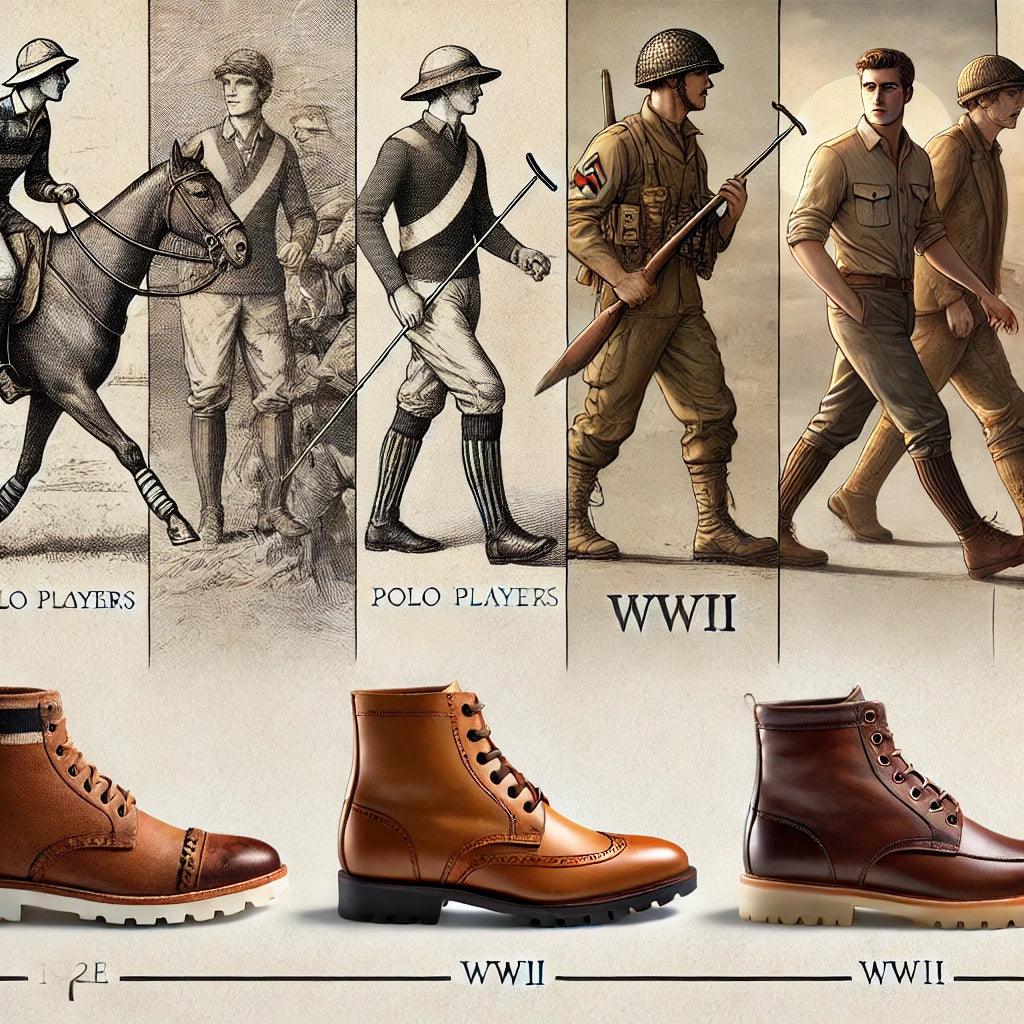
The History of Chukka Boots: From Polo Fields to Fashion Staples
Share
Chukka boots have made a lasting impact on the world of fashion, emerging as a go-to choice for both casual and semi-formal settings. Their simple, elegant design and versatility have allowed them to transcend decades and cultures. But what exactly is the origin of these iconic boots? How did they evolve from a utilitarian piece of footwear to a style staple for both men and women around the world?
In this detailed exploration, we’ll trace the rich history of chukka boots—from their early connections with polo to their mainstream popularity, and their cultural significance in various eras.
Early Origins: Polo and the Birth of the Chukka Boot
The history of the chukka boot begins on the polo fields. Polo, often referred to as “the sport of kings,” has a long history dating back to ancient Persia, around 6th century BC. The game spread across Asia and the Middle East before making its way to British shores in the 19th century. British officers stationed in India became particularly fond of the game, and with them, the sport’s influence reached Europe and North America.
What is a Chukka?
The word "chukka" is derived from the term used in polo, where it refers to a period or round of play. Polo games are typically divided into 7-minute intervals, known as chukkas. Given this connection, the term "chukka boot" may have been inspired by the practical footwear that polo players wore between or after matches—simple, ankle-high boots that allowed for comfort and flexibility both on and off the field.
Though the exact design and use of early chukka boots are somewhat murky, one theory suggests that they were worn by players and spectators alike during post-game socializing. Their lightweight construction, typically featuring a minimal number of eyelets and soft leather or suede uppers, made them ideal for relaxed, post-game attire.
The 20th Century: From Sport to Civilian Wear
Chukka boots didn’t remain confined to polo fields for long. By the early 20th century, their practical, comfortable design began to gain popularity among civilians, particularly in England. However, it wasn’t until World War II that the boots truly made their mark on the world of fashion and function.
World War II and the Rise of Desert Boots
During World War II, British soldiers stationed in North Africa found themselves facing an entirely new set of challenges. Their standard-issue military boots were too bulky and rigid for the harsh, desert environment. The solution? A modification of the chukka boot that became known as the desert boot.
Desert boots, a close cousin of the traditional chukka boot, were adapted with a crepe rubber sole and made from soft, lightweight suede. The crepe sole provided better traction in sandy conditions, and the suede uppers kept soldiers’ feet cooler in the desert heat. The design was based on the type of boots British soldiers had seen worn by locals in the Cairo bazaar.
Clarks, the British shoe company, capitalized on this design after the war, bringing the desert boot to the mass market in 1950. Nathan Clark, a member of the founding family of Clarks, introduced the design based on what he'd seen during his time serving in the British Army. His desert boot design became an instant hit, particularly in post-war Britain, and it helped pave the way for chukka boots' continued popularity in the fashion world.
Post-War Fashion: Chukka Boots in the 1950s and 1960s
By the 1950s, chukka boots had firmly established themselves as a versatile, stylish option for everyday wear. Their ability to blend effortlessly into casual and semi-formal outfits made them especially popular in post-war Britain and America, where men’s fashion was becoming more relaxed.
The 1960s saw chukka boots continue to grow in popularity, particularly among counterculture movements and young men seeking an alternative to traditional, more formal footwear. The boots’ minimalist design appealed to the aesthetic of the time, fitting in with the more relaxed, casual styles that were beginning to dominate fashion.
While desert boots were still a prominent style, more refined leather chukkas were also becoming a favorite for men who wanted to look polished without appearing too formal. The boots found their way into offices, bars, and social events, marking a shift in how fashion approached the line between casual and formal wear.
Chukka Boots in Popular Culture
Throughout the latter half of the 20th century, chukka boots made frequent appearances in popular culture, becoming associated with celebrities and tastemakers who helped solidify their place as a style staple.
The 1960s and Hollywood
Chukka boots gained a foothold in Hollywood during the 1960s, worn by style icons like Steve McQueen. Often referred to as the “King of Cool,” McQueen helped elevate the chukka boot’s status by frequently pairing them with rugged, masculine outfits. He famously wore a pair of sand-colored desert boots in several films, and his off-screen style was also heavily influenced by the boot's casual yet refined aesthetic.
Actors such as Paul Newman and even musicians like Bob Dylan were also seen wearing chukka boots during this era, further embedding them into the fabric of 1960s style and culture.
Mod Culture and Chukka Boots
In Britain, chukka boots also became associated with the Mod subculture during the 1960s. Mods were known for their sharp, tailored fashion choices and their embrace of minimalist, functional designs. Chukka boots, especially sleek leather versions, fit perfectly into this aesthetic. Mods paired their chukka boots with slim-cut suits and casual outfits alike, blending street style with a touch of elegance.
The Evolution of Chukka Boots in Modern Fashion
While the 1960s and 1970s saw chukka boots firmly establish their place in fashion, the boots have continued to evolve with the times. Modern iterations of the chukka boot can be found in a wide variety of materials, colors, and styles, appealing to men and women alike.
The 1980s and 1990s: A Versatile Staple
The 1980s and 1990s continued the trend of chukka boots as a versatile wardrobe staple. These decades saw a rise in fashion diversity, with people experimenting more with how they dressed, and chukka boots remained a constant in men’s fashion due to their adaptability.
As business casual dress codes began to emerge in workplaces, the chukka boot became a key player in bridging the gap between dress shoes and casual sneakers. Leather chukkas, in particular, became a popular choice for office settings, offering a polished yet approachable look.
The 21st Century: A Revival of Classic Style
Chukka boots have seen something of a revival in the 21st century, with designers and fashion enthusiasts alike rediscovering their timeless appeal. As fashion continues to embrace more versatile, functional designs, chukka boots have experienced a resurgence in popularity among both men and women.
In the modern era, brands such as Clarks, Allen Edmonds, and Frye have kept the chukka boot at the forefront of their collections, offering various iterations in leather, suede, and other materials. While traditional colors like brown, black, and tan remain popular, many designers have also experimented with bolder colors and materials to keep the style fresh.
Women's Chukka Boots
Though traditionally associated with men's fashion, chukka boots have also become a popular choice for women’s footwear. Modern women’s chukka boots tend to feature slimmer profiles and more varied material options, such as softer suede and lighter fabrics. Paired with skinny jeans or dresses, women’s chukkas bring a touch of rugged sophistication to casual outfits.
Why Chukka Boots Have Stood the Test of Time
So, what is it about chukka boots that have allowed them to remain relevant for over a century? A few key factors contribute to their enduring appeal:
-
Versatility: Chukka boots can be dressed up or down, making them suitable for a wide range of occasions. Whether paired with jeans, chinos, or even a suit, chukkas provide an understated yet polished look.
-
Comfort: The minimalistic design of chukka boots often results in a comfortable fit, especially when crafted from softer materials like suede or flexible leather. Desert boots, with their crepe rubber soles, are particularly noted for their comfort.
-
Timeless Design: The chukka boot’s simple, clean lines have helped it stay in style for decades. Unlike trend-driven footwear, chukkas offer a classic design that can be adapted to new fashion movements without losing their core appeal.
-
Cultural Significance: From their roots in polo to their popularity among style icons like Steve McQueen, chukka boots have a rich cultural history that adds to their appeal.
Conclusion: A Boot with a Lasting Legacy
Chukka boots have traveled a long and fascinating road—from the polo fields of India to the deserts of North Africa, from Hollywood movie sets to modern runways. Their history is one of adaptability, evolving from a utilitarian necessity to a fashion icon. Today, chukka boots remain as relevant as ever, continuing to straddle the line between casual and formal, all while providing comfort and style in equal measure.
Whether you're drawn to the rugged look of desert boots or the sleek sophistication of leather chukkas, one thing is certain: these boots aren't going anywhere anytime soon. The chukka boot is a testament to the enduring power of simple, functional design—a footwear staple that truly stands the test of time.

1 comment
How about the cover of the Beatles Abbey Rd ? As a 9 yr old, I always thought George Harrison was wearing Cukka Boots. They became extremely popular with kids too.